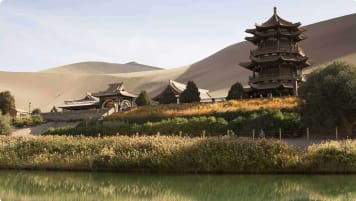Exploring Uzbekistan: The Definitive Guide
Exploring Uzbekistan In a 2018 article, The British newspaper The Telegraph described Uzbekistan as “the most fascinating country you’ve never been to”. Decades of isolation, particularly during Soviet rule, have pushed it down the list…
7 Jun 19 · 10 mins read
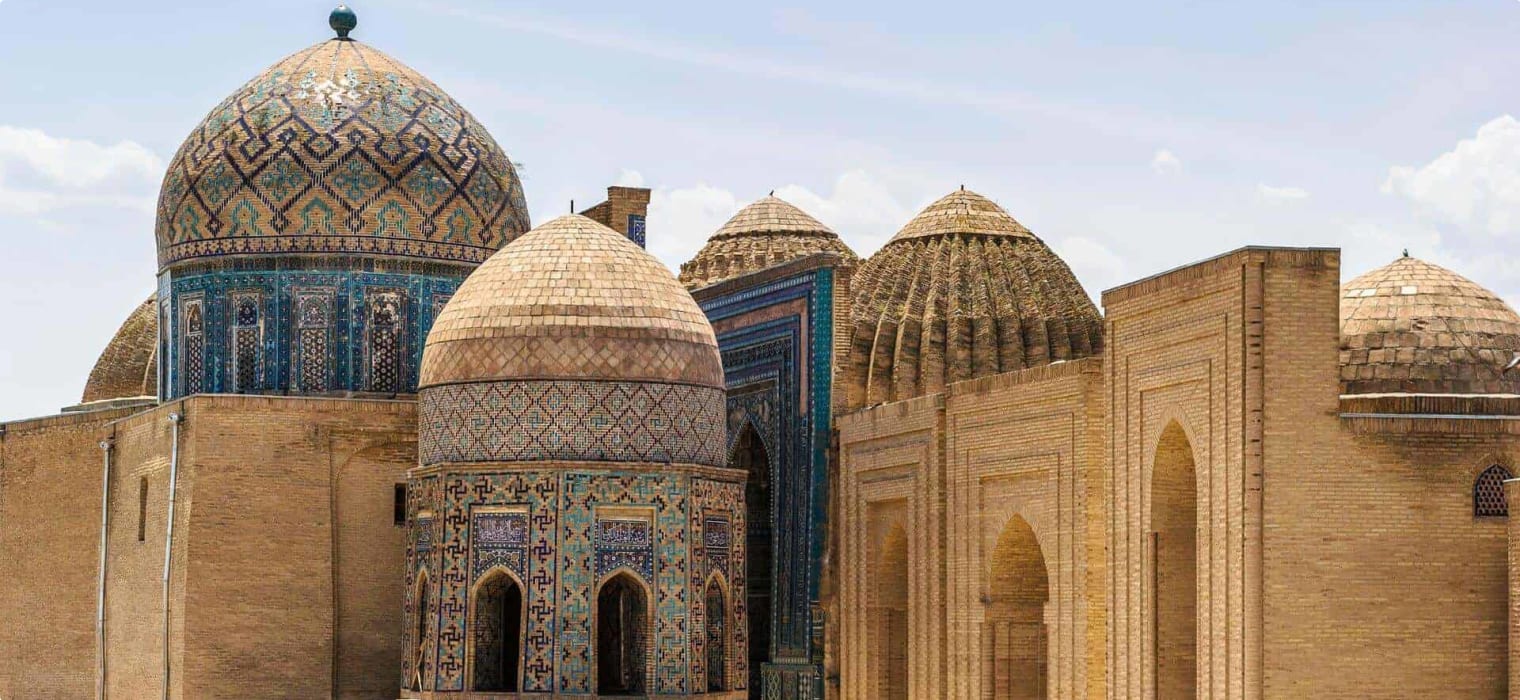
Exploring Uzbekistan
In a 2018 article, The British newspaper The Telegraph described Uzbekistan as “the most fascinating country you’ve never been to”.
Decades of isolation, particularly during Soviet rule, have pushed it down the list (if it were ever on the list at all) of places to visit for travellers. For example, 1,000 Britons visit this Central Asian country annually–not a bad number, but incredibly small when compared to the nine million Britons who take a yearly trip to Spain. Hemmed in by Kazakhstan to the north, Kyrgyzstan to the east, Tajikistan to the southeast, Afghanistan to the south, and Turkmenistan to the southwest, Uzbekistan is doubly landlocked–that is, it is surrounded entirely by landlocked countries, one of only two in the world (the other being Liechtenstein). Despite having no direct access to the ocean, it offers a beguiling mix of Soviet and Islamic architecture and sights, infused with two millennia of human history.
If you’ve ever been curious about this Central Asian city, visiting it is easier now more than ever. Uzbekistan is making itself more accessible to international tourists. In 2018, it introduced a new e-visa option to travellers from 51 countries, and added 45 more countries beginning February 2019.
In this article, let’s look at a brief overview of Uzbekistan’s history, and explore its must-see sites.
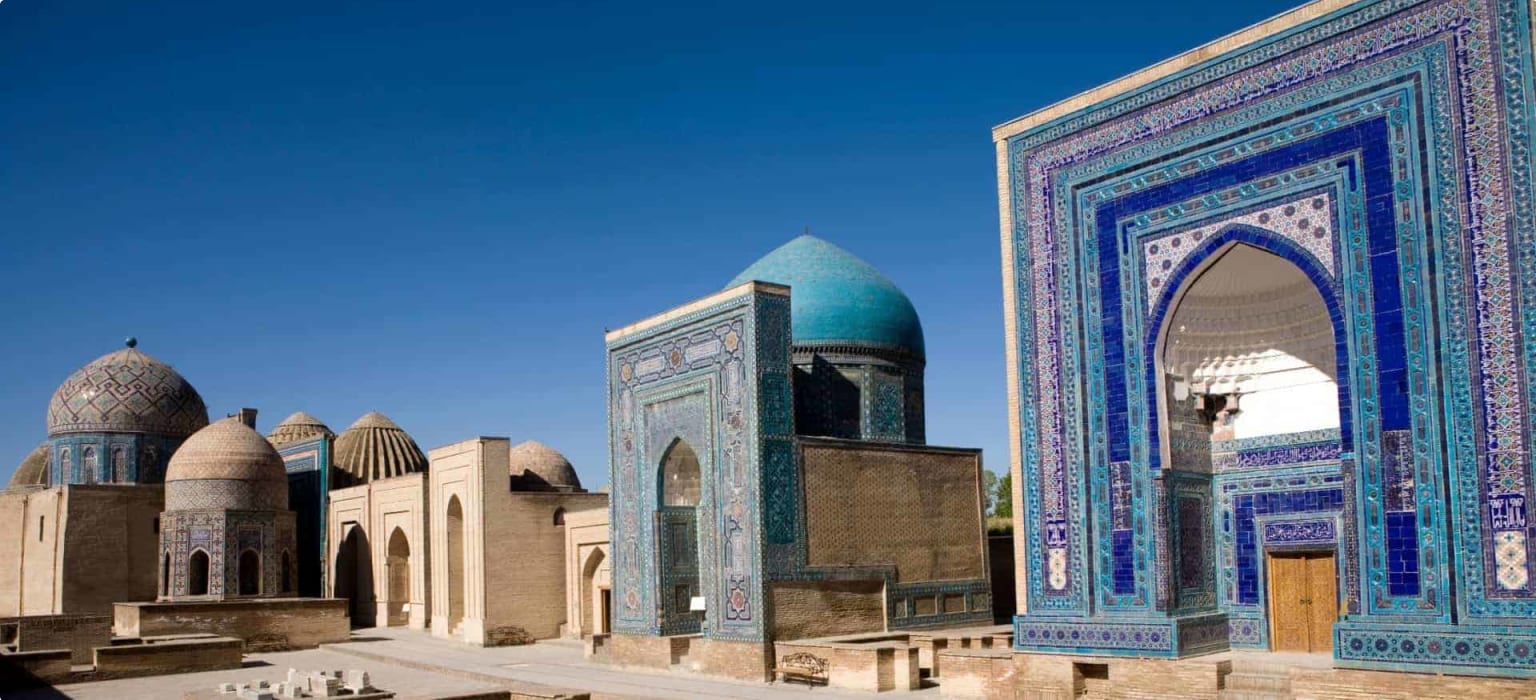
Uzbekistan’s Early History: Sogdiana
The region that is now Uzbekistan has witnessed human settlements since the Paleolithic Period (Old Stone Age), when early humans first picked up stone to make tools. These tools and monuments have been discovered across Uzbekistan, unveiling the beginning of a very long history. An Indo-Iranian nomadic tribe known as Scythians to the Greeks and Sakas to the Persians lived in the region as a “loose nomadic dynasty” who fought on horseback, according to Calum Macleod and Bradley Mayhew in Uzbekistan: The Golden Road to Samarkand (Odyssey Books & Maps, 8th edition, 2017, p. 14).
Cyrus the Great of the Persian Achaemenid Empire fought with the Sakas, who were later absorbed into the empire. The empire conquered and ruled several satrapies (provinces) ruled by a satrap (governor). One of these satrapies was Sogdiana (or Sogdia) with its capital in Samarkand (“stone fort“, located in present-day Uzbekistan) although historical interpretations regarding Persian control vary. Some historians say Sogdiana was ruled by the satrap in nearby Bactria (which covered modern Afghanistan, Uzbekistan, and Tajikistan); some say it was not conquered at all; and others say if it were conquered, Persian control was likely indirect as Sogdiana was a distant provincial frontier.
In any case, the Sogdians were listed in the Achaemenid Royal Inscription and described as producers of semiprecious stones such as lapis lazuli and carnelian. They also provided soldiers for the Persian king Xerxes.
Sogdians, like most of the empire, largely followed Zoroastrianism, the faith of the Achaemenids. This ancient Persian state religion is arguably the world’s oldest monotheistic faith, founded by the prophet Zoroaster (Zarathustra in Persian) who taught followers to worship Ahura Mazda. Fire is a sacred symbol. Before the Achaemenids took over, Sogdiana was home to a Bronze Age civilisation, and was even mentioned in the Zoroastrian holy book Avesta as a good creation of Ahura Mazda.
The Sogdians constructed the famous oasis cities of Samarkand and Bukhara that became incredibly wealthy during the days of the Silk Road (read our articles here, here, and here), but long before the trade routes opened they had already been engaging in overland trade. Many of the Sogdians fled east and became travelling merchants when Alexander the Great’s forces marched into their city.
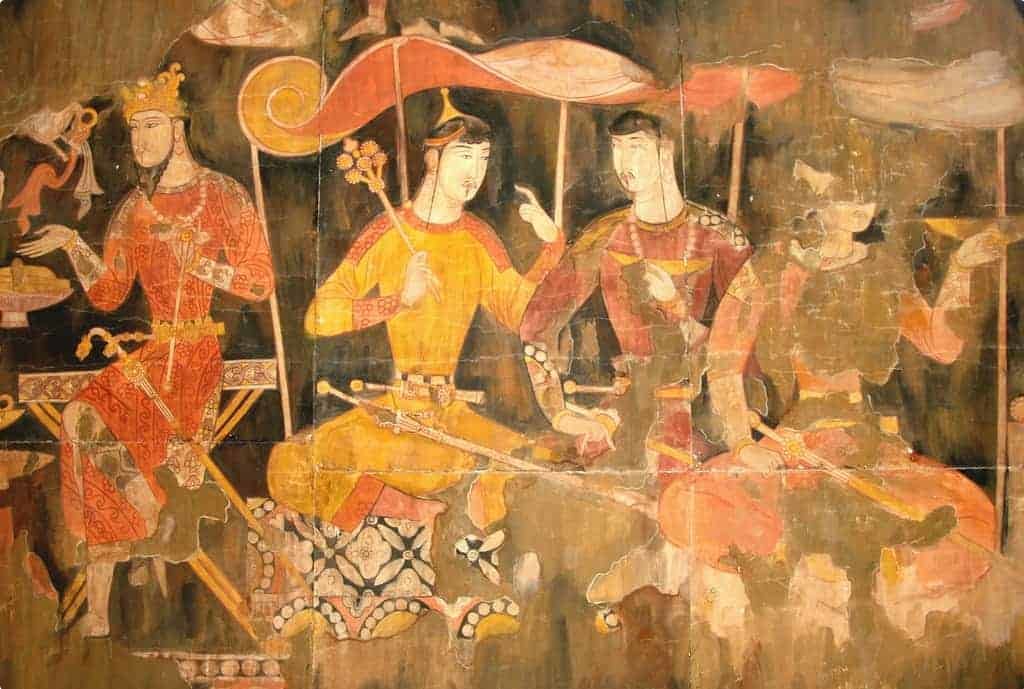
Alexander the Great and pre-Islamic Conquerors
After his father Philip II was assassinated, 20-year-old Alexander III ascended the throne in 336 BC and immediately planned his conquest of the Persian Empire. Alexander conquered one city after another and faced the Persian emperor Darius III in 333 BC near the town of Issus in what is now Turkey, but that didn’t go well for Darius. The Persian leader fled in haste, even leaving his family behind.
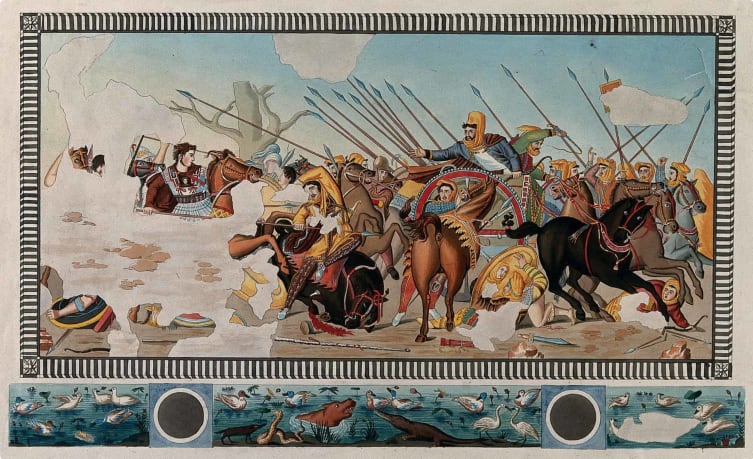
Darius and Alexander would face each other again in 331 BC, but once again Darius would flee, this time to Bactria. He wouldn’t be as lucky as the last time. In Bactria, he was believed to have been assassinated by the satrap Bessus. Alexander dispatched Bessus and conquered the city of Samarkand (Maracanda to the Greeks) in 329 BC and married the Bactrian Roxana in 327 BC. Alexander the Great became Persian and Macedonian emperor.
After Alexander’s untimely death at the age of 32, however, his empire became divided. In the eastern regions, his rule was succeeded by the Hellenistic Seleucid Empire (312 BC to 63 BC). In rebellion against the Seleucids, the Parthian or Arsacid Empire (247 BC to 224 AD) rose, succeeded by the Sasanian or Sasanid Empire (224 to 651 AD). The Seleucids and the Parthians were heavily influenced by their Greco-Macedonians predecessors, but the Sasanians saw themselves as the successors of the Achaemenid Dynasty. Their reign was seen as a return to the values, culture, and religion of old Persia, and was the last, great Persian empire before the Islamic conquest.
Arabs, Mongols, Timur, and the Uzbeks
The Sasanian Empire eventually declined following chaotic warfare with their main rival, the Roman (followed by the Byzantine) Empire, and with nomadic Turks who were streaming in from the east. But it was the Arabs who would take over the region of what is now Uzbekistan by the 8th century, converting the Zoroastrians to Islam. The Mongols came in during the 13th century, and after Genghis Khan’s death, the land was ruled by his second son Chagatai Khan as the Chagatai Khanate.
Born in Samarkand within this khanate was a boy who would grow up to become the warrior Timur (or Tamerlane).
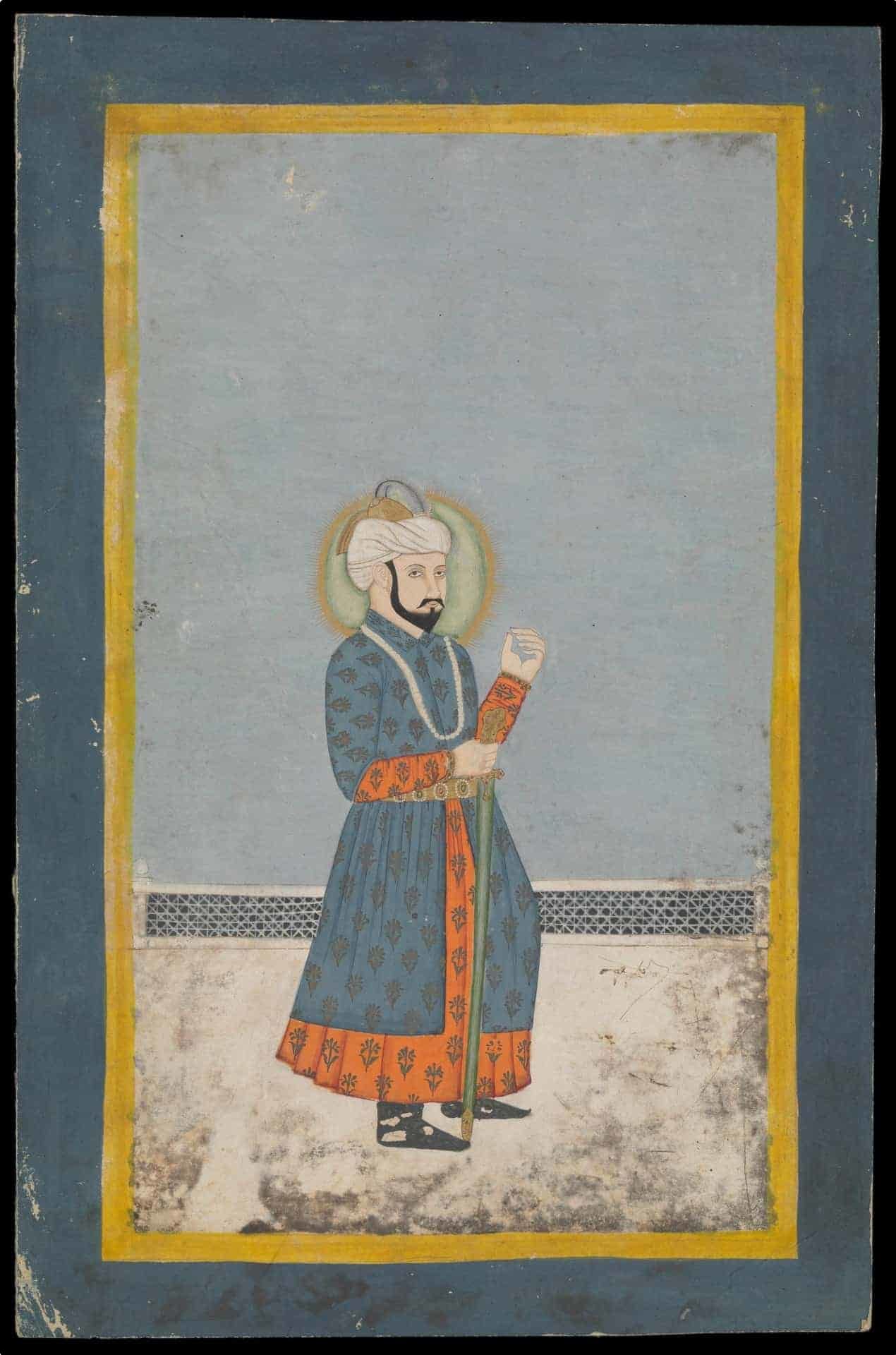
Timur saw himself as a successor of Genghis Khan, and in the 14th century went on to conquer the separate khanates to rule them under one empire. His violent charge across Central Asia reportedly left 17 million people dead. He had plans of invading Ming China, but died before even reaching the Chinese border. His huge empire began to fall apart upon his death.
(Timur, known as Amir Timur or Timur the Great, has been embraced as a national hero in post-Soviet Uzbekistan, regarded as “a wise statesman and nation builder” instead of a “bloodthirsty tyrant”, according to a 1997 New York Times article by Stephen Kinzer.)
In the 16th century, a Turkic-Mongol tribe called the Uzbeks came from northwestern Siberia. They were believed to have taken their name from the leader of the Golden Horde, Öz Beg or Uzbek Khan, who reigned from 1312 to 1341. (The Golden Horde was one of the four Mongol territories that formed after Genghis Khan’s death, in addition to the aforementioned Chagatai Khanate, the Ilkhanate, and the Yuan dynasty.) Abū al-Khayr became Uzbek khan in 1428 and would reign as leader for 40 years.
The Uzbeks were a tribe of many forming their own independent khanates, such as the Kazakh Khanate (read more here) which broke away from Al-Khayr and later formed the seed of modern Kazakhstan.
By the 18th century there were separate principalities in the region, notably Khiva, Kokand, and Bukhara.
Uzbekistan Under Soviet Russia
These states were captured by Russian forces in the 19th century, with Kokand annexed to the Russian empire and Khiva and Bukhara becoming vassal states.
After the Russian Revolution of 1917 overthrew the tsar and installed the Bolsheviks to power, the region saw the formation of the Turkistan Autonomous Soviet Socialist Republic (1918), the Khorezm People’s Republic (1920) and the Bukhara People’s Republic (1920). All three were abolished by Joseph Stalin, then Commissar for Nationalities, in 1924, to draw new Soviet socialist republics divided by ethnic lines.
The Uzbek SSR was formed that year, with an Uzbek consistently the head of the Communist Party, the only legal party in the Soviet republic. The Uzbek SSR at the time included territories of what is now Tajikistan and Kazakhstan.
The consequences of forced collectivisation in 1928 in the Uzbek SSR mirrored what happened in the Kazakh ASSR. By 1937, nearly all (95%) of the land in Central Asia was collectivised, forcing nomadic tribes to a sedentary life (Macleod & Mayhew, 2017, p. 35). Succeeding years of corruption, cruelty, and deaths under the Soviet Union led to a growing nationalism among the Uzbeks.
Still, the Uzbek communist party leaders supported the Russian coup against Gorbachev. But when the coup failed, the former Soviet socialist republic declared its independence from the Soviet Union in 1991. To quote Macleod & Mayhew (2017), “1924’s jigsaw borders [drawn by Stalin] suddenly became real international boundaries” (p. 35). The leader of the Communist Party of Uzbekistan, Islam Karimov, became its first president.
Must-See Sites in Uzbekistan
With the country’s relaxation of visa restrictions, it is now much easier to get into and around Uzbekistan. Simon Calder (2019) on The Independent calls it “the heart” of the historic Silk Road network, and there is plenty to see and do as you follow in the footsteps of Central Asian conquerors and merchants.
Uzbekistan summers (June to early August) can be hot, with afternoon temperatures soaring above 35 degrees Celsius, and temperatures during winter (December to early February) dropping to -10 degrees Celsius in many cities (Macleod & Mayhew, 2017, p. 68). Odyssey Traveller has a tour to Uzbekistan, Kazakhstan, Kyrgyzstan, Turkmenistan that travels during spring (May) and autumn (August) so programme participants can enjoy pleasant weather.
Tashkent

Tashkent, the country’s capital, is a common entry point for travellers. A 1966 earthquake caused massive destruction in the city, and the Soviet rebuilding led to the city’s distinctive look of stoic Soviet buildings, classical Russian architecture, and blue-tiled mosques.
Amir Timur maydoni (Amir Timur Square) features Uzbekistan’s national hero on horseback. Towering over the square is Hotel Uzbekistan, built in the Soviet style in 1974. Another Soviet-influenced structure is the beautiful Tashkent Metro, modelled after the Moscow Metro and opened in 1977. Photography in the underground metro was banned before, but the ban has been lifted since 2018.
You can take the metro to the city’s famous farmers market, the Chorsu Bazaar, where you can buy bread, fruit, and spices.

Samarkand
Uzbekistan has a comfortable, high-speed train network that can take you from Tashkent to Samarkand in just two hours. Samarkand was Timur’s hometown, and the grand square of Registan (“Sandy Place” in Persian) the heart of the Timurid dynasty he built.
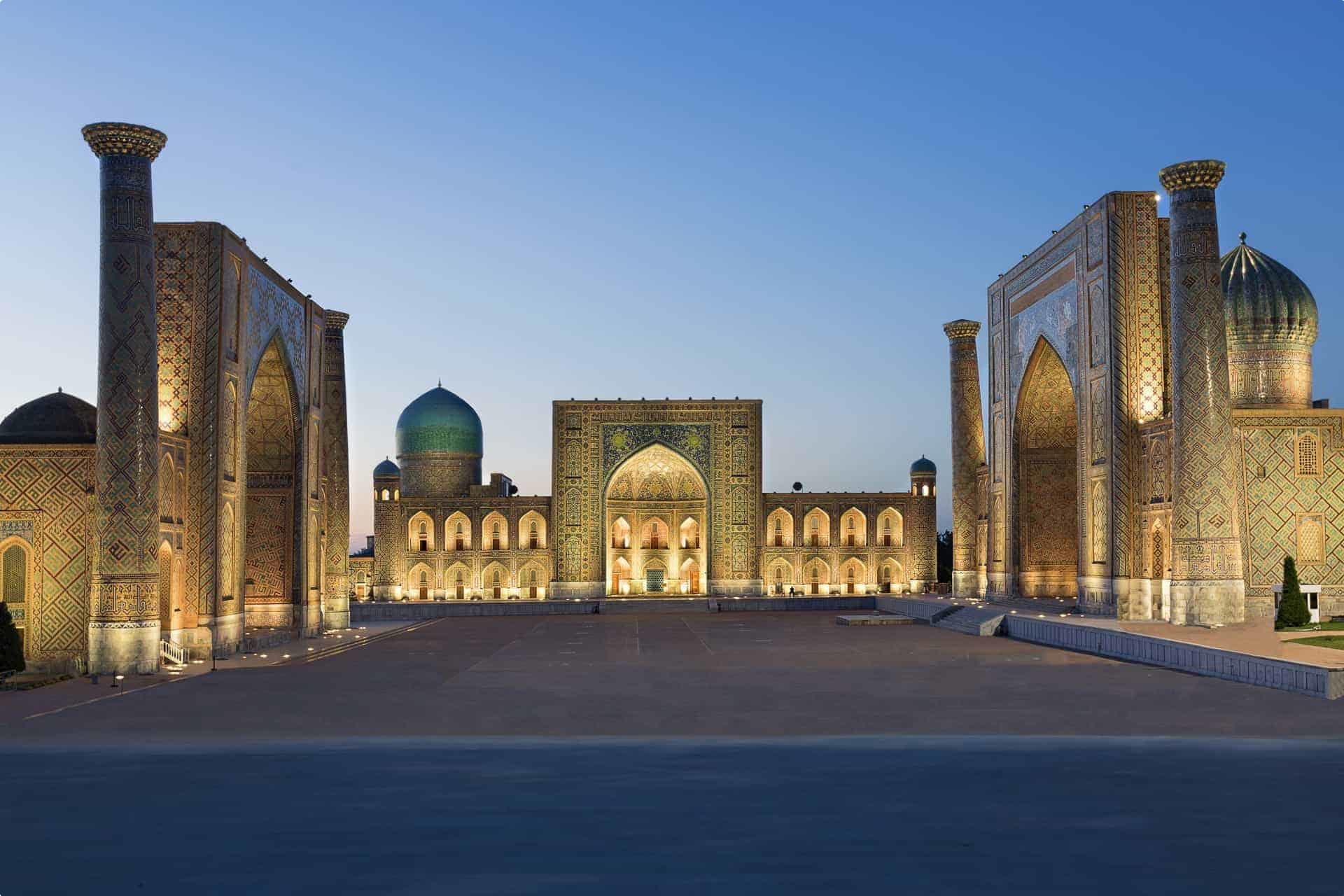
The tiled medieval commercial centre and public square has three impressive madrasahs (Islamic religious schools), built by the artisans and craftsmen that Timur brought home with him (or possibly kidnapped) during his 14th-century conquests. The city grew prosperous during the Silk Road, and Registan once had markets and cavaranserai (roadside inns) to cater to merchants and travellers seeking an oasis in the desert.
Bukhara
Also situated on the Silk Road (and equally accessible from Tashkent via high-speed rail) is the historic city of Bukhara. It was a cultural centre of the 8th century Caliphate and has a large number of 17th century madrasahs.
Bukhara’s Ark is its oldest structure, a fortress inhabited from the 5th century until it was bombed by the Red Army in 1920. Museums rose within its ruins, where visitors can learn about the city’s history.
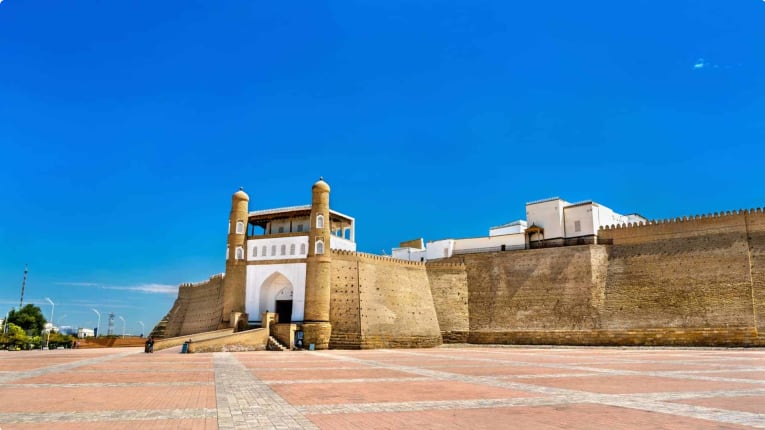
The oldest Muslim monument in the city is the 10th century Ismail Samani Mausoleum, built for Ismail Samani (or Isma’il ibn Ahmad) the founder of the Samanid dynasty, a Persian dynasty that ruled from 819 to 999, covering present-day Afghanistan, large parts of Iran, Tajikistan, Turkmenistan, Uzbekistan, Kyrgyzstan, and parts of Kazakhstan and Pakistan.

The 47-metre Kalon Minaret, built in the 12th century, was where the glazed blue tiles that we now see all over Uzbekistan was first used.
Khiva
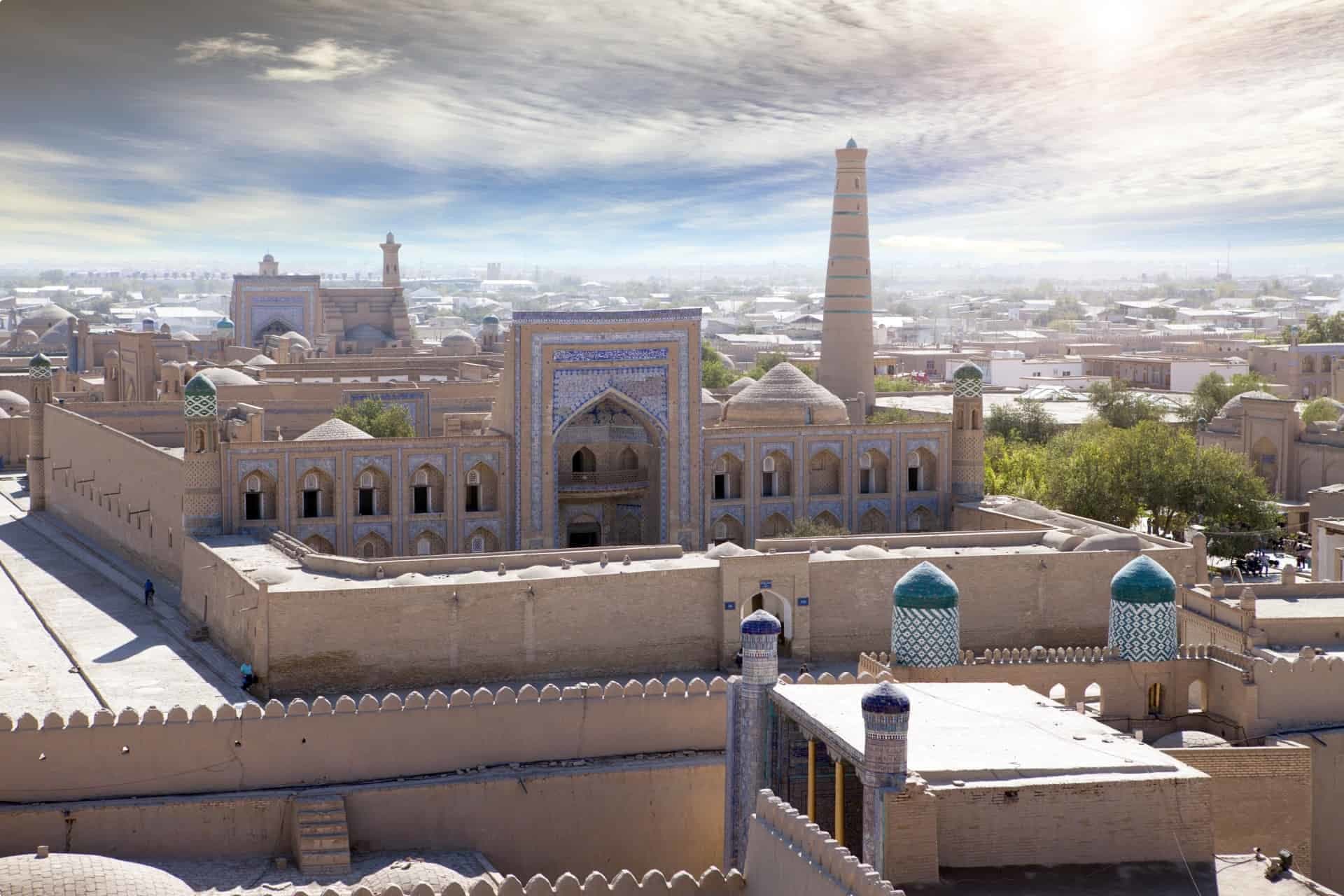
Another Silk Road old town is Khiva. Its inner town, Itchan Kala, is well-preserved and protected by 10-metre-high brick walls. Itchan Kala served as the last stop of caravans before crossing the desert to Iran. About 3,000 people live within the walls, with land only passed down through families (meaning, you can’t buy land here).
The 10th century Djuma Mosque (also spelled Juma Mosque) is held up by carved wooden colonnades. Its 33-metre minaret is the highest point in Khiva, offering a breathtaking vantage point to view the town’s minarets and madrasahs.
Nukus
Nukus in southwestern Uzbekistan is capital of the autonomous republic of Karakalpakstan lying along the Aral Sea, a lake largely drained by the Soviet Union for irrigation to increase production of cotton, a major Soviet export.
Established as a province of the Kazakh ASSR, it became an autonomous republic and placed within the Uzbek SSR in 1936. It remained an autonomous republic within Uzbekistan after the fall of the Soviet Union in 1991.

A famous site in Karakalpakstan near Nukus city is the Mizdakhan Necropolis. Mizdakhan was once the second-largest city in Khorezm. Khorezm is a historic region that formed part of the Achaemenid Empire, in what is now Turkmenistan and Uzbekistan. It later became the heart of the Khiva Khanate that became a vassal state of Russia.
Once an important Zoroastrian city, Mizdakhan was captured by the Arabs in the 8th century, converting the city to Islam. It is now a Muslim pilgrimage site, and is believed to be the final resting place of the first man (Adam).
Nukus is home to the Savitsky Museum (officially: The State Art Museum of the Republic of Karakalpakstan) which houses a vast collection of Soviet art, including avant-garde work that artist Igor Savitsky managed to save from destruction during the regime of Stalin, who imposed strict rules on the creation of art within the Soviet Union. “Socialist Realism” banned pessimistic or critical elements. In visual artwork–paintings, murals, mosaic, and sculptures–this meant using realist styles to show optimistic and idealistic depictions of life in the Soviet Union. Socialist Realism was the official aesthetic of the Soviet Union and its territories until the late 20th century. (Read more in our article here.)
As The Guardian reports, “Savitsky risked everything for this collection. Some of these painters were tortured or murdered or spent long years in the gulags.” Read more in Suzanne Moore’s article here.
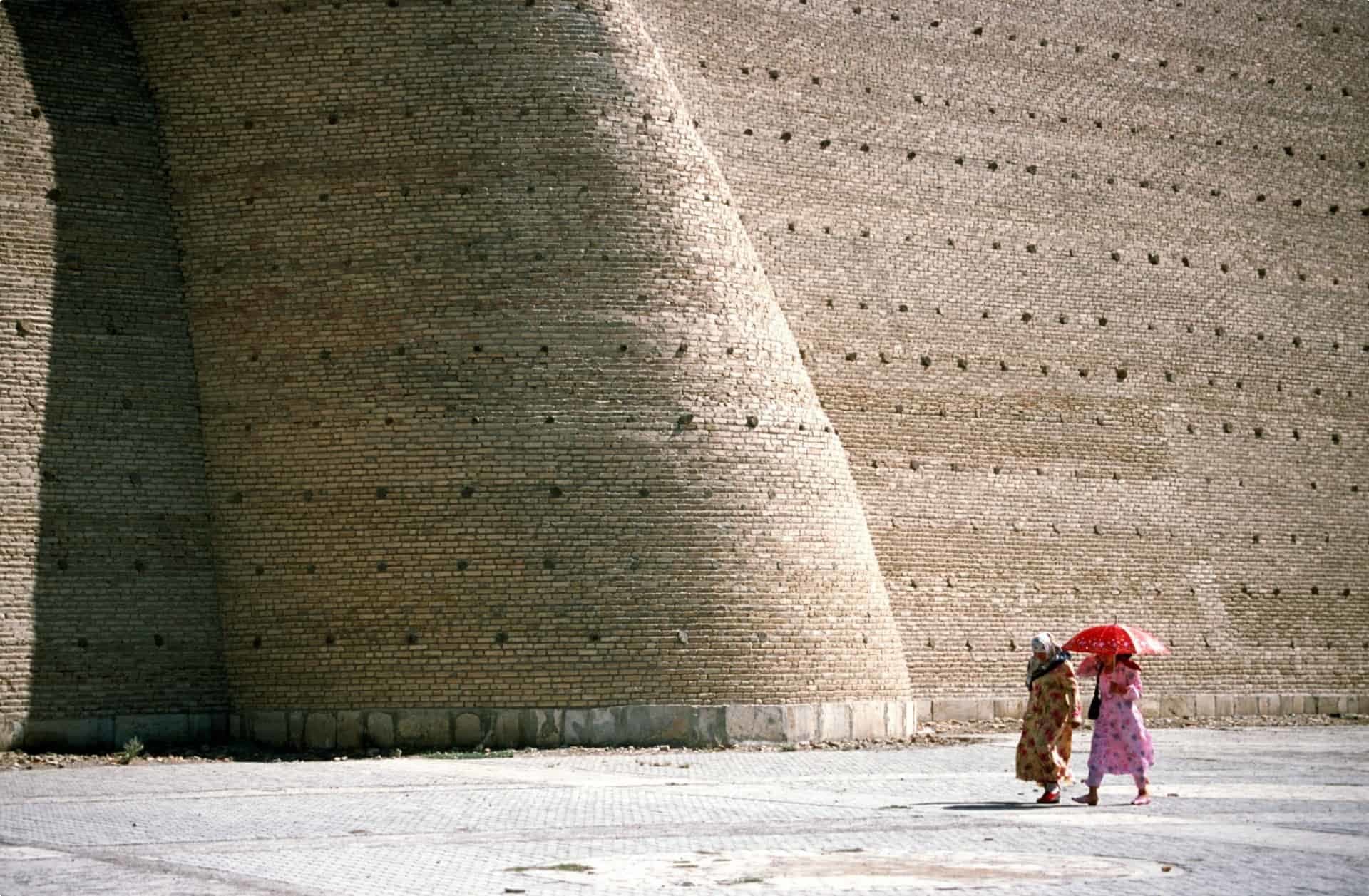
If you want to learn more, do consider joining Odyssey Traveller’s tour to Uzbekistan, Kazakhstan, Kyrgyzstan, and Turkmenistan. This is a 27-day tour especially designed for senior travellers that begins in Uzbekistan. On this tour, we explore Tashkent, Samarkand, Bukhara, Khiva and Nukus, and other great cities and towns in Central Asia. Click here to see the full itinerary and sign up!
The encircled numbers on the map below refer to the number of nights spent in each destination, with green indicating the starting point, and the red circle the end point.
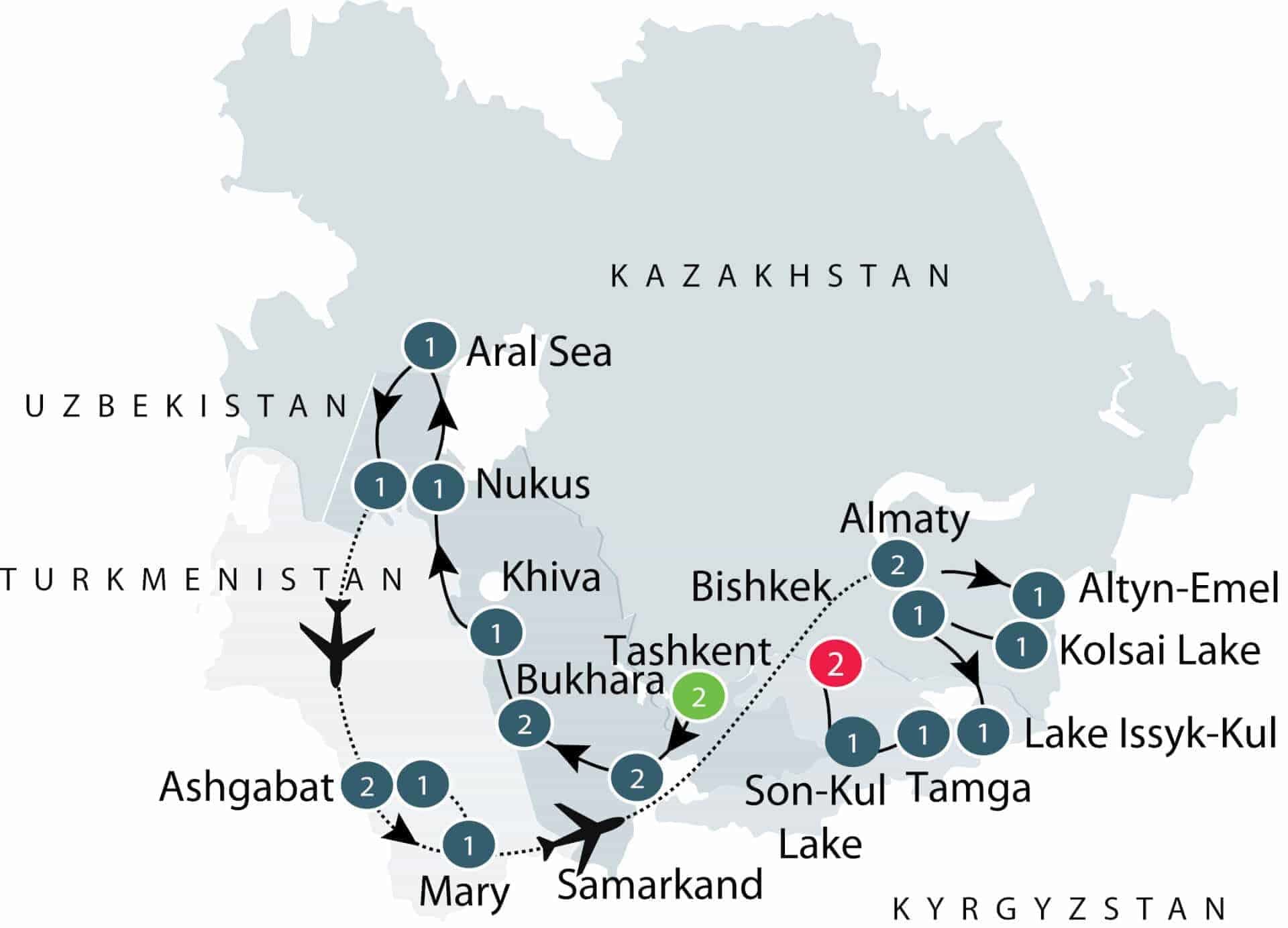
Related Tours
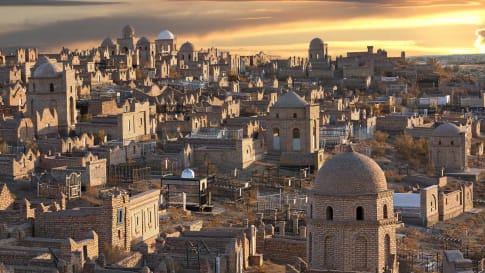
28 days
May, AugThe Stans Small Group Tour: Uzbekistan, Kazakhstan, Kyrgyzstan, and Turkmenistan
Visiting Kazakhstan, Kyrgyzstan
This journey is crafted for the adventurous traveller—whether solo or as a couple—seeking a small group tour through Central Asia. Be prepared for a variety of accommodations, scenic walking excursions, and a few full travel days. The itinerary blends stunning landscapes, a mix of ancient and modern history, as well as authentic encounters with local families and dramatically different ways of life.
From A$17,650 AUD
View Tour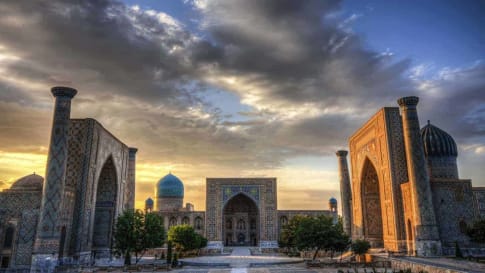
29 days
Aug, May, SepTravel on the Silk Road with Odyssey Traveller | Small Group Tour for Seniors
Visiting China, Kyrgyzstan
The Silk Road is an ancient trade route linking China and Imperial Rome through Central Asia. Few areas in the world remain as unexplored or offer such richness in terms of ancient and modern history, culture, and scenic diversity as Central Asia. Our Small group Silk road tours itinerary explores the Road through remote deserts and mountainous environments as we visit key sites between Xi'an and Bukhara.
From A$19,685 AUD
View Tour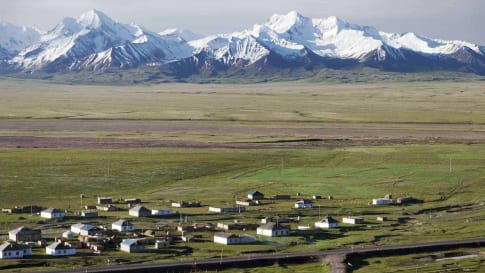
7 days
Jun, SepTajikistan Tour | Central Asian Small Group Tour
Visiting Tajikistan
We explore the country’s astonishing scenery and monuments. Tajikistan is the smallest of the 5 ‘Stans and is also the most mountainous. On our small group tour for couples and solo travelers we encounter many ranges and mountain chains where we reach well over 3,000 metres above sea level while crossing passes.
From A$4,950 AUD
View Tour